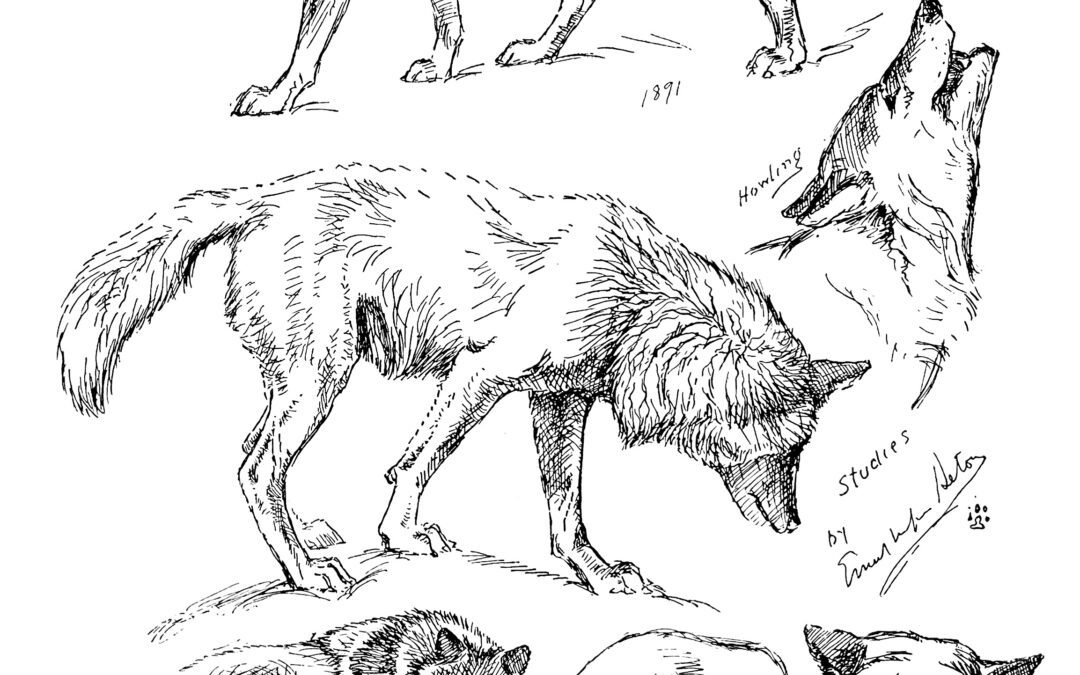Wolf Studies by Ernest Thompson Seton
This is one in an ongoing series of nature essays and artwork from Lives of Game Animals (1925-1928) by Ernest Thompson Seton. Seton’s analysis of Gray Wolf behavior was groundbreaking at the time. Since he devoted a large section of his Lives to Wolves, I am presenting his work over several postings.
In this part Seton comments on our changing knowledge about wolves. How much of this reflects changes within wolves and how much is it about changes in our perceptions? New observations lead us into a continual reassessment of these creatures.
HABITS IN GENERAL/VOL I PG. 300-302
“The Gray-wolf is one of the shyest of wild animals. I have talked with men who have lived their whole lives in regions where Gray-wolves were far from rare, and yet they have never seen one. They hear them at night, they see their trails and their work in the morning, but never see the animals themselves until they have been trapped or poisoned. Their extreme shyness is partly a modern development, as also is the respect for man, which now fully possesses every Gray-wolf in the Cattle country. There are many records that show the Wolf to have been a continual danger to mankind in the bow-and-arrow days. There can be no doubt that then man was considered a fair prey— a difficult and wide-awake one, no doubt, but still a creature to be eaten in times of scarcity. Consequently, each winter in America, as in Europe, a number of human beings were killed and devoured by hungry Wolves.
During the last 50 years, however, I cannot find a reliable instance of Wolves killing or even attacking human beings.
A QUESTION OF BALANCE
The question then arises, are the old records wrong, relating, as they do, the frequent destruction of man by Wolves; so much so that in the ancient days of Europe, the Wolf was the most dreaded of wild animals? Or are the modern Wolves of different species?
The answer is, the modern Wolves are the same as the old ones, except in one particular, viz., that they have been educated by gunpowder to let man alone. Man with the modern gun is a different creature from man with the bow and arrow. The Wolves have learned this, and are now no more a menace to human life than are the Prairie-wolves or Coyotes. Not only do they abstain from harming man, but they have learned that they are likely to be harmed by him, unless they keep out of sight in the daytime. This, I think, is why Wolves are so rarely seen, even where comparatively common.
In accounting for these changes, it is not necessary to attribute human intelligence to this animal. Evidently much hard luck and many unpleasant surprises have engendered in it a deep and general distrust of all strange things, as well as a well-founded fear of anything that bears the taint of a human being. This distrust, combined with its exquisite sense of smell, may explain much that looks like profound sagacity in this animal. Nevertheless, this will not explain all, as I have had very good reason to remark again and again, when I have endeavoured to trap or poison Wolves on the Cattle ranges.
And even ascribing much to mere shyness does not remove it from the sphere of intelligence, though doubtless ranking it lower in that department, making it a vague fear of the unknown, in place of a dread of danger well comprehended.”

